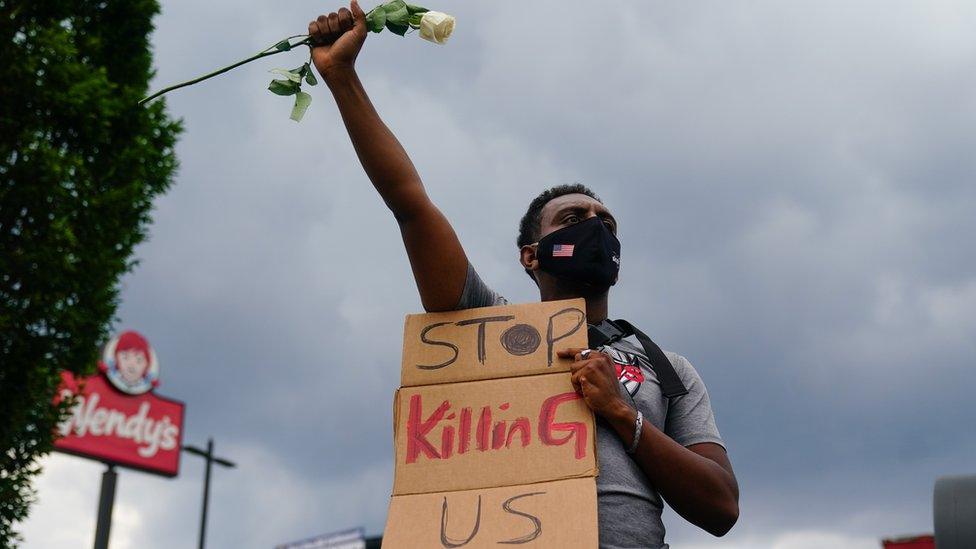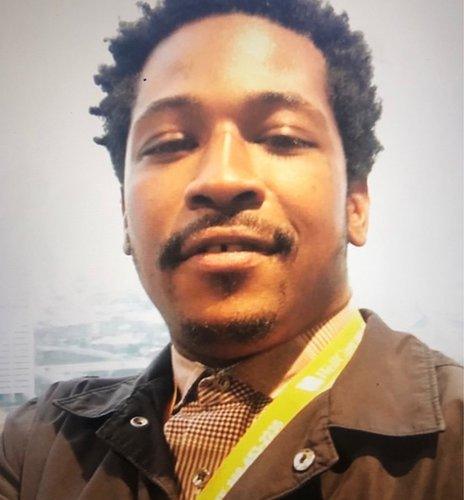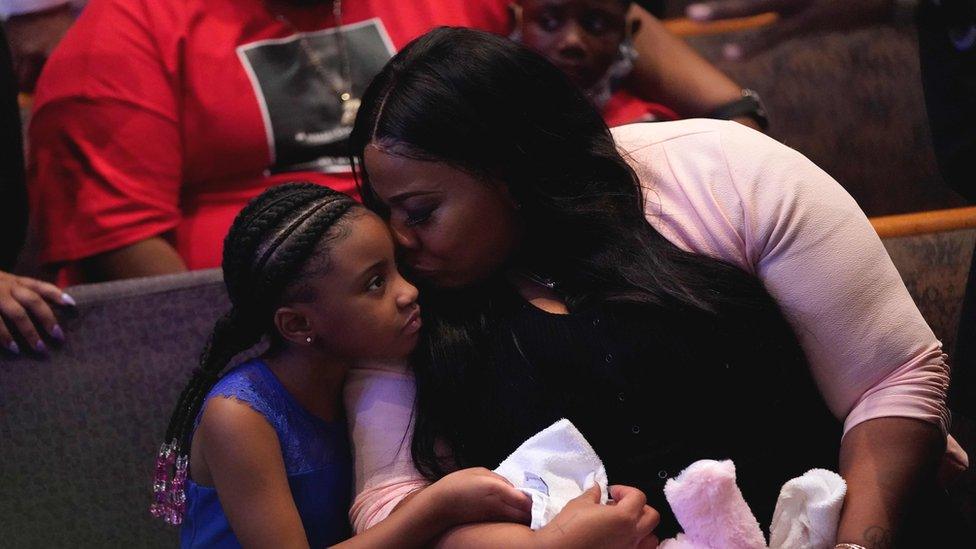Atlanta police shooting: Rayshard Brooks death declared homicide
- Published
The Wendy's drive-through restaurant was set on fire over Mr Brooks' shooting
A medical examiner in Atlanta, Georgia, has declared the death of an African-American man to be homicide after he was shot in an encounter with police.
Rayshard Brooks died while fleeing from two white police officers in a restaurant car park late on Friday.
Protests erupted after his death, weeks after another black man, George Floyd, was killed in custody in Minneapolis.
Atlanta's police chief quit and the police officer suspected of shooting Mr Brooks was fired.
Following his death, the Wendy's drive-through restaurant where he was stopped was set on fire on Saturday.
Thousands of people joined Black Lives Matter protests across the US at the weekend.
In Brooklyn, New York, on Sunday, thousands gathered for a rally and silent march for black transgender lives. Organisers estimate that 15,000 people assembled for the event.
In Chicago, a statue of the first US President, George Washington, was spray-painted with the words "slave owner".
Washington was an active slave holder for 56 years. While he spoke of his desire to end the practice, at the time of his death in 1799, 317 enslaved people lived on his Mount Vernon estate.
The founding father left instructions in his will for the 123 slaves he owned outright to be freed, only once his wife Martha had died.
Allow X content?
This article contains content provided by X. We ask for your permission before anything is loaded, as they may be using cookies and other technologies. You may want to read X’s cookie policy, external and privacy policy, external before accepting. To view this content choose ‘accept and continue’.

And anger over the killing of Mr Floyd, who died as a police officer held his knee on his neck on 25 May, fuelled new protests over the weekend in the UK.
What is the latest on the Atlanta shooting?
On Sunday evening, more than 100 people turned out in the rain at the site of the shooting for a peaceful protest.
According to the Fulton County medical examiner, the manner of death of Rayshard Brooks was "homicide." He suffered two gunshots to the back that caused organ injuries and blood loss.

Fulton County District Attorney Paul Howard told CNN that three charges could apply against sacked police officer Garrett Rolfe: murder, felony murder and aggravated assault.
"But I believe in this instance, what we have to choose between, if there's a choice to be made, is between murder and felony murder," Mr Howard said.
Tomika Miller, the wife of Mr Brooks, said she wants the officers involved in the shooting to be sent to prison.
The Georgia Bureau of Investigations (GBI) says officers were called to the fast-food restaurant because Mr Brooks had fallen asleep in his car, which was blocking the drive-through lane.
Body camera footage released by the police department shows the two officers administering a sobriety test - where a suspect is asked, for instance, to walk in a straight line - and then a breathalyser test, with Mr Brooks's permission.
The two officers then try to handcuff him, at which point their body cams fall off, but security camera video shows them struggling with Mr Brooks on the ground.
He then grabs an officer's Taser (electric stun gun) and breaks free from the officers, running away.

Rayshard Brooks (undated photo)

As he is chased, Mr Brooks is seen turning around and pointing the Taser before continuing to run and then being shot.
"As I pursued him, he turned and started firing the Taser at me," Mr Rolfe told a supervisor after the shooting in a videotaped conversation. "He definitely did shoot it at me at least once."
GBI spokeswoman Nelly Miles said she could not confirm whether Mr Brooks had indeed fired the Taser, the Associated Press reports.
Atlanta Mayor Keisha Lance Bottoms said she did not believe the shooting was a "justified use of deadly force".
This is the 48th "officer-involved shooting" the GBI has investigated this year, according to ABC News. Of those cases, 15 were fatal, external.
Why this case is different
Analysis by Jessica Lussenhop, BBC News
The swiftness with which a white police officer was fired in the killing of Rayshard Brooks is just the latest sign of how rapidly and dramatically police agencies have shifted strategy when it comes to dealing with deadly force cases.
Historically, not only have police chiefs been reticent to fire officers involved in in-custody deaths until a "full investigation" had taken place, they've been quick to defend the officer's use of force if he or she "reasonably" believed that a person had a deadly weapon or posed immediate danger to the officer.
In this case, video shows that Brooks had taken the officer's Taser and appears to use it. But not only is the weapon non-lethal, the video shows he was running away and that the shots that killed him entered his back.
If the officer is criminally charged in this case, the question of whether or not a Taser should be considered a deadly weapon will surely come into play, as well as whether the officer had "reasonable" fear of Brooks.
But at this stage, what is already clear is that police departments are not feeling nearly as confident relying on the old strategies and rhetoric that historically have allowed them to slow-play their response to a police-involved killing.
What are lawmakers doing?
Last week, House Democrats introduced sweeping legislation, demanding federal police use body and dashboard cameras, banning the use of chokeholds, eliminating unannounced police raids known as "no-knock warrants" and making it easier to prosecute police for misbehaviour.
The Justice in Police Act of 2020 also calls for the end of "qualified immunity" - designed to give police legal breathing room surrounding their decisions on the job and frequently used to dismiss excessive force cases against officers.
On Sunday, Republican Senator Tim Scott described this element of the Democrat's bill as a "poison pill" for Republicans, making the measure impossible to pass.
Mr Scott, the lone African-American Republican senator, is spearheading his own party's legislative efforts to address police reform.
His own proposal includes a system for local police departments to better report cases in which officers' actions result in injury and death, and improved officer training.
President Donald Trump is also expected to sign an executive order on police reform on Tuesday, establishing national standards for use of force.
Meanwhile, police forces across the country are introducing reforms - several have banned the use of chokeholds unless there is a threat to life.
- Published10 June 2020
